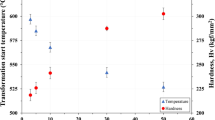We propose a method for automated determination of grain geometry, based on the analysis of digital metallographic images of the microstructure of exploited 12Kh1MF steam-pipeline steel. This method enables one to analyze images with indistinctly delineated grain boundaries by means of interactive processing. We have shown that, with approach to the pipe surfaces, the grain size grows at its straight part and decreases at its bend in the tension zone, which is evidence of recrystallization processes in high-strained metal. If one evaluates grain sizes by changes in the metal hardness, then the distribution of grain sizes across the pipe wall in the tension zone of bend does not agree with the Hall – Petch law, which can be a result of intense operational degradation of the bend metal.
Similar content being viewed by others
References
V. V. Panasyuk, H. M. Nykyforchyn, O. Z. Student, and Z. V. Slobodyan, “Application of the approaches of fracture mechanics to evaluating the hydrogen degradation of steels of oil and steam pipelines,” in: O. E. Andreikiv, I. I. Luchko, and V. V. Bozhydarnyk (editors), Mechanics and Physics of Fracture of Building Materials and Structures [in Ukrainian], Kamenyar, Lviv (2002), pp. 537–546.
O. M. Romaniv, H. M. Nykyforchyn, O. Z. Student, et al., “Effect of the operational damage of 12Kh1MF steam-pipeline steel on the characteristics of its crack resistance,” Fiz.-Khim. Mekh. Mater., 34, No. 1, 101–104 (1998).
O. Z. Student, “Accelerated method for hydrogen degradation of structural steel,” Mater. Sci., 34, No. 4, 497–507 (1998).
E. I. Krutasova, Reliability of Metal of Power-Generating Equipment [in Russian], Énergoizdat, Moscow (1981).
H. V. Krechkovs’ka, O. Z. Student, and A. D. Markov, “Structural changes in the metal of a steam pipeline of thermal power plant, made of 15Kh1M1F steel, induced by its operation,” in: Scientific Notes [in Ukrainian], Issue 20, Luts’k State Tech. Univ., Luts’k (2007), pp. 213–217.
V. S. Zolotarevskii, Mechanical Properties of Metals [in Russian], Metallurgiya, Moscow (1983).
V. M. Farber, B. Z. Belen’kii, and B. I. Gol’dshtein, “Evaluation of the strength of low-carbon low-alloyed steels according to structural data,” Fiz. Met. Metalloved., 3, No. 2, 403–409 (1975).
ASTM E 112. Standard Test Methods for Determining Average Grain Size.
GOST 5639-82. Methods for Revealing and Determining Grain Size [in Russian], Izd. Standartov, Moscow (1976).
GOST 21073.0-75. Nonferrous Metals. Determination of Grain Size. General Requirements [in Russian], Izd. Standartov, Moscow (1976).
GOST 21073.1-75. Nonferrous Metals. Determination of Grain Size by the Method of Comparison with the Scale of Microstructures [in Russian], Izd. Standartov, Moscow (1976).
GOST 21073.2-75. Nonferrous Metals. Determination of Grain Size by the Method of Grain Counting [in Russian], Izd. Standartov, Moscow (1976).
GOST 21073.3-75. Nonferrous Metals. Determination of Grain Size by the Method of Counting of Grain Intersections [in Russian], Izd. Standartov, Moscow (1976).
GOST 21073.4-75. Nonferrous Metals. Determination of Grain Size by the Planimetric Method [in Russian], Izd. Standartov, Moscow (1976).
ASTM E 1382-97. Standard Test Methods for Determining Average Grain Size Using Semiautomatic and Automatic Image Analysis.
R. K. Melekhov and V. I. Pokhmurs’kyi, Structural Materials of Power-Generating Equipment [in Ukrainian], Naukova Dumka, Kyiv (2003).
P. A. Antikain, Metals and Strength Analysis of Boilers and Pipelines [in Russian], Énergoatomizdat, Moscow (1990).
P. Shahinian and J. R. Lane, “Influence of grain size on high temperature properties of monel,” Trans. ASM, 45, 177 (1953).
V. M. Rozemberg, Creep of Metals [in Russian], Metallurgiya, Moscow (1967).
F. Garofalo, L. Zwell, A. S. Keh, and S. Weissmann, “Structure formation in iron during creep at 600°C,” Acta Met., 9, 721 (1961).
L. Wojnar, K. Kurzydlowski, and J. Szala, Praktyka Analizy Obrazu, Krakow (2002).
R. C. Gonzalez and R. E. Woods, Digital Image Processing, 2nd ed., Prentice Hall, Upper Saddle River, NJ (2002).
Author information
Authors and Affiliations
Corresponding author
Additional information
Translated from Fizyko-Khimichna Mekhanika Materialiv, Vol. 45, No. 3, pp. 23–29, May–June, 2009.
Rights and permissions
About this article
Cite this article
Zhuravel’, I.M., Svirs’ka, L.M., Student, O.Z. et al. Automated determination of grain geometry in an exploited steam-pipeline steel. Mater Sci 45, 350–357 (2009). https://doi.org/10.1007/s11003-009-9187-2
Received:
Published:
Issue Date:
DOI: https://doi.org/10.1007/s11003-009-9187-2




